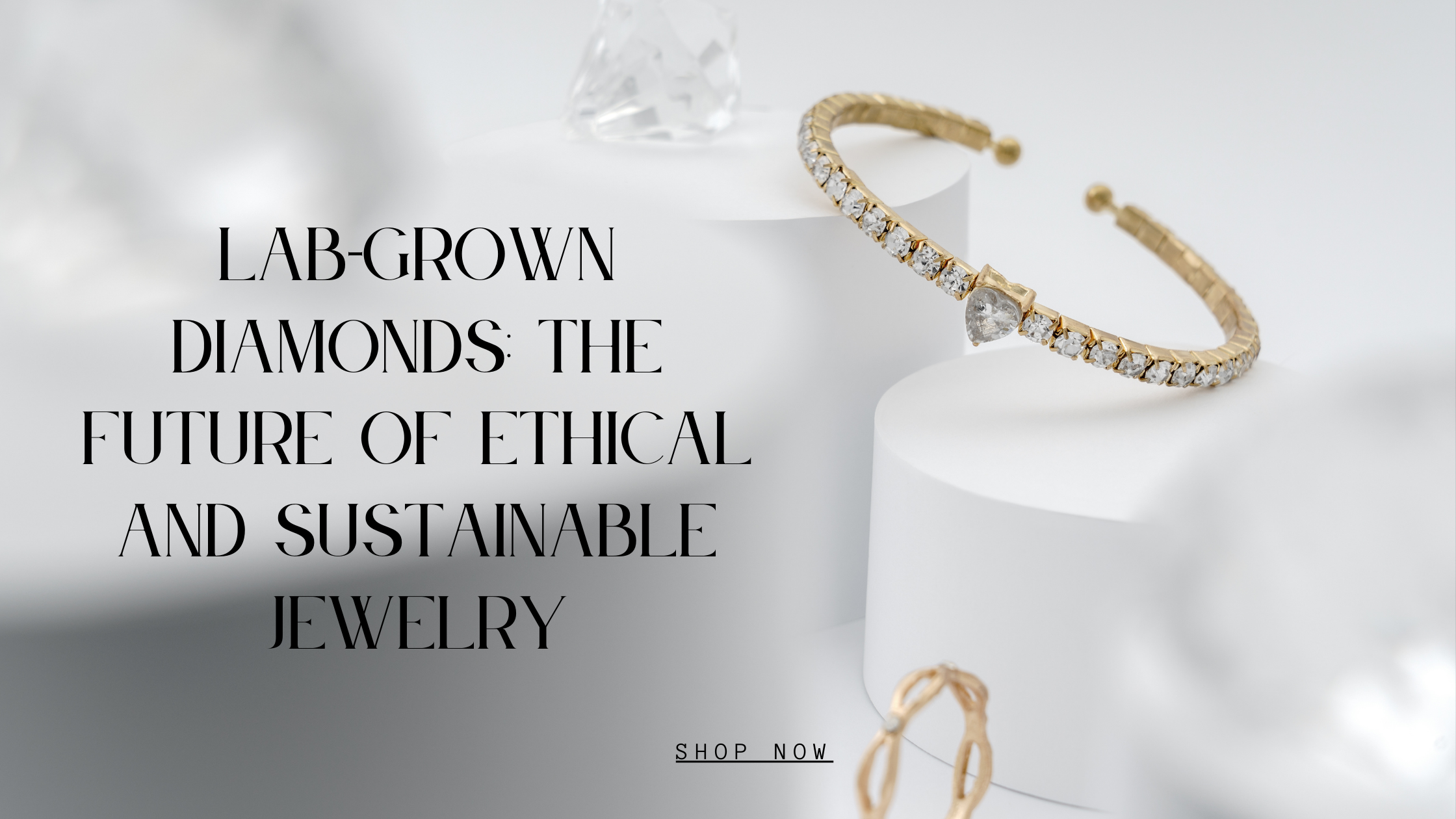
Lab-Grown Diamonds: The Future of Ethical and Sustainable Jewelry
In the world of luxury and elegance, diamonds have long been considered the ultimate symbol of love, commitment, and status. However, as the global conversation shifts toward sustainability and ethical sourcing, a new player has emerged in the diamond industry: lab-grown diamonds. These man-made gems are revolutionizing the jewelry market, offering a more ethical, sustainable, and affordable alternative to traditionally mined diamonds.
In this comprehensive guide, we’ll explore what lab-grown diamonds are, how they are made, their benefits over mined diamonds, and why they are becoming increasingly popular.
What Are Lab-Grown Diamonds?
Lab-grown diamonds, also known as synthetic or cultured diamonds, are diamonds that are created in a laboratory setting rather than being mined from the earth. These diamonds are chemically, physically, and optically identical to natural diamonds, making them a genuine alternative to mined diamonds. The only difference is their origin.

The Science Behind Lab-Grown Diamonds:
Lab-grown diamonds are made using two primary methods: High-Pressure High-Temperature (HPHT) and Chemical Vapor Deposition (CVD). Both methods mimic the natural conditions under which diamonds are formed in the earth’s mantle.
- High-Pressure High-Temperature (HPHT) Method: In the HPHT process, a small diamond seed is placed in a carbon source, such as graphite. The seed is then subjected to extremely high temperatures (around 1500°C) and pressures (about 1.5 million pounds per square inch), conditions similar to those found deep within the earth. Under these conditions, the carbon atoms bond to the seed, forming a diamond.
- Chemical Vapor Deposition (CVD) Method: The CVD process involves placing a diamond seed in a chamber filled with a carbon-rich gas, such as methane. The chamber is heated to around 800°C, causing the gas to break down and the carbon atoms to bond to the seed, layer by layer, forming a diamond. The CVD method allows for more precise control over the growth process, making it easier to create diamonds with specific characteristics.
Read More: The Science Behind lab grown diamond
Benefits of Lab-Grown Diamonds:
Lab-grown diamonds offer several significant advantages over their mined counterparts, making them an attractive option for environmentally-conscious consumers and those looking for high-quality jewelry at a more affordable price.
Read More:
1. Ethical Sourcing
One of the most compelling reasons to choose lab-grown diamonds is their ethical sourcing. Traditional diamond mining has long been associated with environmental destruction, human rights abuses, and conflict diamonds (also known as blood diamonds), which are mined in war zones and sold to finance armed conflict against governments. In contrast, lab-grown diamonds are created in a controlled laboratory environment, free from the ethical concerns associated with mining.
- No Conflict Diamonds: Since lab-grown diamonds are not mined, there is no risk of supporting conflict or human rights abuses. Consumers can purchase lab-grown diamonds with the confidence that they are not contributing to unethical practices.
- Fair Labor Practices: The production of lab-grown diamonds takes place in safe, regulated environments where workers are fairly compensated, unlike many mining operations in developing countries where labor exploitation is common.
2. Environmental Sustainability
The environmental impact of diamond mining is significant, involving the removal of large amounts of earth, deforestation, and the use of harmful chemicals. Lab-grown diamonds, on the other hand, have a much smaller environmental footprint.
- Reduced Land Disturbance: Mining for natural diamonds requires the removal of vast amounts of earth, leading to habitat destruction and soil erosion. Lab-grown diamonds do not require any land disturbance, making them a more sustainable choice.
- Lower Carbon Emissions: The energy required to create lab-grown diamonds is significantly lower than that needed for mining. While both processes require energy, advancements in technology are making lab-grown diamonds increasingly energy-efficient. Additionally, some labs are powered by renewable energy sources, further reducing their carbon footprint.
- Water Conservation: Diamond mining uses large amounts of water, often in areas where water is scarce. Lab-grown diamonds, in contrast, use far less water in their production, helping to conserve this vital resource.
3. Affordability
Another major benefit of lab-grown diamonds is their affordability. Because they are produced in a laboratory, lab-grown diamonds are typically 20-40% less expensive than mined diamonds of comparable size and quality. This cost difference makes it possible for consumers to purchase larger or higher-quality diamonds within their budget.
- More Value for Money: Consumers can often afford a larger or higher-quality lab-grown diamond for the same price as a smaller, lower-quality mined diamond.
- Accessible Luxury: The lower cost of lab-grown diamonds makes them accessible to a wider range of consumers, allowing more people to enjoy the beauty and luxury of diamonds.
4. Quality and Variety
Lab-grown diamonds offer the same quality and variety as mined diamonds, with the added benefit of precision control during production. This control allows for the creation of diamonds with specific characteristics, such as color, clarity, and cut.
- Consistency in Quality: Because lab-grown diamonds are created in a controlled environment, they tend to have fewer inclusions and impurities than natural diamonds, resulting in higher clarity grades.
- Availability of Colors: Lab-grown diamonds can be produced in a variety of colors, including rare and sought-after hues like blue, pink, and yellow. These colored diamonds are often more affordable than their mined counterparts.
5. Innovation in Jewelry Design
The availability of affordable, high-quality lab-grown diamonds opens up new possibilities for jewelry designers. This has led to greater innovation and creativity in the design of diamond jewelry, particularly in the use of colored and custom-shaped diamonds.
- Rings and Bracelets: Lab-grown diamonds are increasingly being used in the creation of rings and bracelets, offering consumers a wide range of designs to choose from. The affordability of lab-grown diamonds allows for more intricate and elaborate designs, making luxury jewelry more accessible.
- Colored Diamonds: The ability to produce lab-grown diamonds in a variety of colors has led to the creation of unique and vibrant pieces of jewelry. Colored diamonds are perfect for those looking to make a bold statement with their jewelry.
- Shaped Diamond Engagement Rings: Lab-grown diamonds can be cut into any shape, allowing for the creation of custom-shaped diamond engagement rings. Whether you prefer a classic round cut or a more modern pear or marquise shape, lab-grown diamonds offer the flexibility to create the perfect engagement ring.

Read More: Lab diamond vs Natural diamond
Why Lab-Grown Diamonds Are Becoming Increasingly Popular:
The popularity of lab-grown diamonds has been on the rise in recent years, driven by a combination of ethical concerns, environmental awareness, and changing consumer preferences. Here are some key factors contributing to the growing demand for lab-grown diamonds:
1. Changing Consumer Values
Today’s consumers are more informed and conscious about the impact of their purchases. Many are choosing products that align with their values, particularly when it comes to sustainability and ethical sourcing. Lab-grown diamonds appeal to this growing demographic of socially and environmentally responsible consumers.
- Millennials and Gen Z: These generations are particularly focused on making ethical and sustainable choices. They are more likely to choose lab-grown diamonds over mined diamonds because they align with their values of environmental stewardship and social justice.
- Transparency and Authenticity: Consumers are increasingly demanding transparency from the brands they support. Lab-grown diamonds offer a clear, traceable origin, providing consumers with the assurance that their purchase is both ethical and sustainable.
Read More: How Lab-Grown Diamonds Are Transforming the Engagement Ring Market
2. Advances in Technology
Technological advancements have made it possible to produce high-quality lab-grown diamonds that are virtually indistinguishable from natural diamonds. These advancements have also led to a decrease in production costs, making lab-grown diamonds more affordable and accessible to a wider audience.
- Improved Production Methods: The development of the CVD method, in particular, has allowed for greater control over the diamond-growing process, resulting in higher-quality stones with fewer defects.
- Increased Production Capacity: As more companies enter the lab-grown diamond market, production capacity has increased, leading to a wider availability of lab-grown diamonds at competitive prices.
3. Celebrity Endorsements and Media Coverage
The visibility of lab-grown diamonds has been boosted by endorsements from celebrities and coverage in the media. As more high-profile individuals choose lab-grown diamonds for their jewelry, the perception of lab-grown diamonds as a luxury product has grown.
- Celebrity Influence: Celebrities who wear lab-grown diamonds on the red carpet or in public appearances help to normalize and popularize them, making them more desirable to consumers.
- Positive Media Coverage: Articles and news segments that highlight the benefits of lab-grown diamonds, particularly their ethical and environmental advantages, contribute to their growing popularity.
4. Competitive Pricing
As mentioned earlier, lab-grown diamonds are more affordable than mined diamonds. This price difference is a significant factor in their rising popularity, particularly among cost-conscious consumers who still want the look and feel of a real diamond.
- Affordability Without Compromise: Consumers no longer have to compromise on quality or size when choosing a diamond. Lab-grown diamonds offer an affordable alternative without sacrificing the characteristics that make diamonds desirable.
- Wider Market Reach: The lower price point of lab-grown diamonds has made them accessible to a broader range of consumers, including those who may not have previously considered purchasing a diamond.
Addressing Common Myths About Lab-Grown Diamonds:
Despite their growing popularity, there are still some misconceptions about lab-grown diamonds that may cause hesitation among potential buyers. Let’s address some of the most common myths:

-
Myth 1: Lab-Grown Diamonds Are Not Real Diamonds
Fact: Lab-grown diamonds are chemically, physically, and optically identical to mined diamonds. They are composed of pure carbon and exhibit the same hardness, brilliance, and fire as natural diamonds. The only difference is their origin. -
Myth 2: Lab-Grown Diamonds Are of Lower Quality
Fact: Lab-grown diamonds can actually be of higher quality than mined diamonds due to the controlled environment in which they are created. They often have fewer inclusions and impurities, resulting in higher clarity grades. -
Myth 3: Lab-Grown Diamonds Have No Resale Value
Fact: While the resale market for lab-grown diamonds is still developing, their value is expected to grow as they become more mainstream. Additionally, the affordability of lab-grown diamonds means that consumers can enjoy them without worrying as much about resale value.
FAQs related to lab grown diamonds:
Is a lab-grown diamond a real diamond?
Yes, a lab-grown diamond is a real diamond, identical to mined diamonds in chemical, physical, and optical properties.
Is it worth buying lab-grown diamonds?
Yes, lab-grown diamonds are worth buying for their ethical sourcing, environmental benefits, and affordability.
What are the disadvantages of lab-grown diamonds?
The primary disadvantage is that lab-grown diamonds may have a lower resale value compared to mined diamonds.
Can a jeweler tell if a diamond is lab created?
Most jewelers cannot tell the difference without specialized equipment, as lab-grown diamonds are virtually identical to mined ones.
Do lab diamonds have resale value?
Yes, but lab-grown diamonds generally have a lower resale value compared to natural diamonds.
How long do lab-grown diamonds last?
Lab-grown diamonds are just as durable as natural diamonds and will last forever.
Why are lab diamonds so cheap?
Lab-grown diamonds are cheaper due to lower production costs and the absence of mining-related expenses.
Do lab diamonds break easily?
No, lab-grown diamonds are as hard and durable as natural diamonds and do not break easily.
Do lab diamonds turn yellow?
No, lab-grown diamonds do not turn yellow over time; they maintain their color just like natural diamonds.
Conclusion: The Future of Jewelry
Lab-grown diamonds represent the future of the jewelry industry. They offer a more ethical, sustainable, and affordable alternative to mined diamonds without compromising on quality or beauty. As consumer values continue to shift toward sustainability and ethical practices, the demand for lab-grown diamonds is only expected to increase.
Whether you’re in the market for an engagement ring, a special gift, or a stunning piece of jewelry for yourself, lab-grown diamonds are a choice you can feel good about. They embody the elegance and luxury of traditional diamonds while aligning with modern values of sustainability and ethical sourcing. As technology continues to advance and the market for lab-grown diamonds grows, they are set to become the new standard in fine jewelry.

